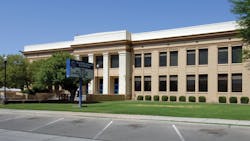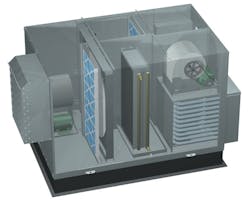Dedicated Outdoor Air, Energy Recovery Rise to School’s Ventilation Challenge
One might not expect mold problems in the arid Arizona climate, but from mid-July through September, the city of Yuma experiences “monsoon season.” Over the years, serious mold issues developed in both buildings on the Yuma High School campus: Old Main, a three-story, 30,000-sq-ft facility built in 1910, and Snider Hall, a two-story, 20,000-sq-ft facility built in 1921. Two-pipe fan-coil units installed in each classroom were not sized to handle increased humidity. Additionally, the buildings were designed to provide only 5 cfm of outdoor air per person, even less of which was delivered because outdoor-air dampers often were closed. The lack of ventilation resulted in carbon-dioxide (CO2) levels of 2,000 to 6,000 ppm.
After spending millions of dollars cleaning up the mold, Yuma School District decided to invest in a more reliable, economical HVAC system. The new system was designed not only to keep the mold problems from reoccurring, but to comply with the 15-cfm-per-person outdoor-air requirement of ANSI/ASHRAE Standard 62.1, Ventilation for Acceptable Indoor Air Quality.
The Solution
John Sternitzke of Sternco Engineers determined a dedicated outdoor-air system with energy recovery would be the most economical solution.
The ventilation system at Yuma High School utilizes Greenheck Model ERCH, which combines the benefits of a total enthalpy wheel with supplemental cooling and heating. Seven ERCH units with chilled-water cooling and hot-water heating were installed. One ERCH unit per floor supplies ventilation air at 65°F and 35-percent RH to the return side of the fan-coil units in each classroom. Exhaust air is pulled from the corridors and routed back to the ERCH unit.
The ERCH units eliminated the need for the fan-coil units to handle the latent load of outdoor air. Also, because the ERCH units handle the entire outdoor-air load, outdoor-air volume was able to be increased to meet current ventilation standards without additional cooling equipment.
Results
More than a year after the ERCH units were installed, tests for mold were negative.
“Our indoor-air quality has improved, especially the humidity,” Dave Folsom, director of maintenance for Yuma School District, said, adding, “CO2 levels have been reduced to 1,200 ppm or less,” while, “Math and science scores have jumped.”
With the ERCH units, Sternitzke was able to specify a semi-custom energy-recovery unit that satisfied the needs of the school district while staying within budget. Additionally, he knows the district has a top-performing ventilation system: The energy wheel is certified per ARI 1060, Rating Air-to-Air Energy Recovery Ventilation Heat Exchangers, while the entire unit is Air Movement and Control Association International-licensed for air performance.
For Design Solutions author guidelines, contact Scott Arnold, executive editor, at 216-931-9980 or [email protected].

